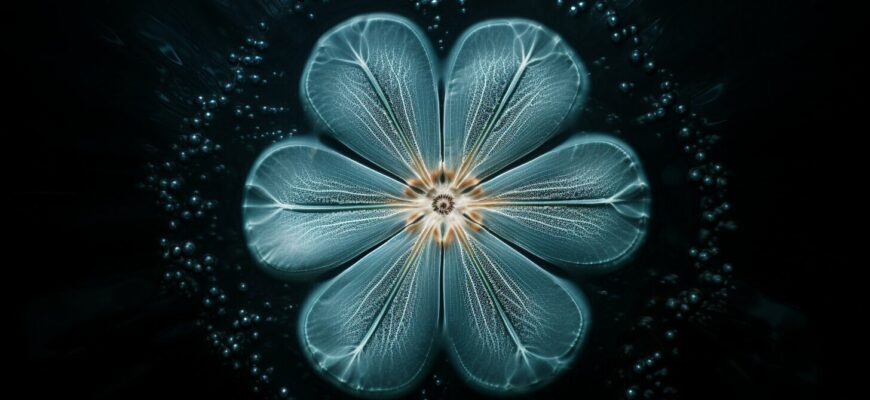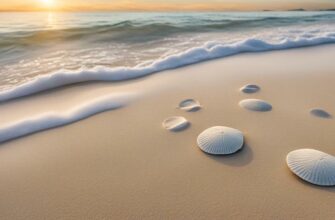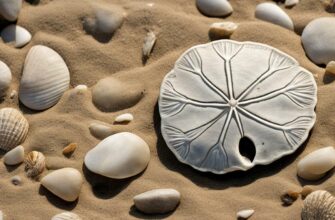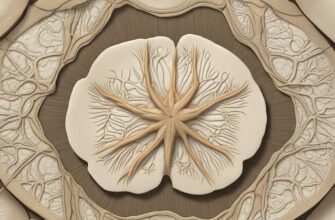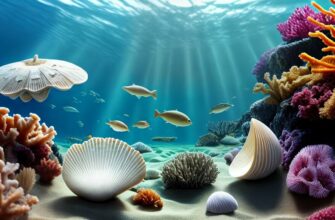Have you ever come across a sand dollar while walking on the beach and wondered how they are made? Sand dollars are fascinating creatures that play an important role in marine ecosystems. Their unique skeletal structure and formation process make them a wonder of nature.
In this article, we will explore the anatomy of a sand dollar, its life cycle, habitat, feeding habits, predators, and defense mechanisms. We will also address some common questions and misconceptions about sand dollars.
- What are Sand Dollars?
- Anatomy of a Sand Dollar
- The purpose of the sand dollar’s skeletal structure
- Formation of Sand Dollars
- Early Stages of Sand Dollar Development
- Habitat and Environment
- Sand Dollar Habitat
- Sand Dollar Environment
- Sand Dollars in Sandy Ocean Floors
- Sand Dollar Distribution
- The Importance of Sandy Ocean Floors
- Feeding Habits of Sand Dollars
- What do sand dollars eat?
- Reproduction and Life Cycle
- Life Cycle Stages
- Predators and Defense Mechanisms
- Frequently Asked Questions (FAQ)
- Are Sand Dollars alive?
- What do Sand Dollars eat?
- Can I keep a Sand Dollar as a pet?
- Why are Sand Dollars white?
- Can Sand Dollars regenerate their limbs?
- Where can I find Sand Dollars?
- Do Sand Dollars have any predators?
- How do Sand Dollars reproduce?
- Are Sand Dollars endangered?
- Can Sand Dollars move?
What are Sand Dollars?
Before diving into the fascinating process of how sand dollars are made, it’s important to understand what they are. Sand dollars are a type of echinoderm, which means they are related to sea stars, sea urchins, and other spiny-skinned creatures. These flat, circular animals are typically found on the sandy ocean floor in shallow waters.
Sand dollars are known for their unique appearance, with a distinct pattern of small holes covering their surface. These holes, called “pores,” are part of the sand dollar’s intricate skeletal system. They also have an oral surface, which is the bottom of the sand dollar where its mouth is located.
While sand dollars may seem like just another creature in the ocean, they play an important role in marine ecosystems. As filter feeders, they help regulate the population of small organisms in the ocean.
Anatomy of a Sand Dollar
Sand dollars are flat, disk-like, and have a unique skeletal structure that sets them apart from other marine organisms. Unlike most other echinoderms that have spines, sand dollars have tiny, bristly hairs (cilia) on the surface of their body that help in movement and feeding.
Their hard, calcareous shell, also known as the test, is round and has a distinct five-pointed star pattern. On the underside, there is a large central disc that is surrounded by a series of grooves, each with tiny feet that help the sand dollar move and feed.
The purpose of the sand dollar’s skeletal structure
The sand dollar’s skeletal structure has several purposes. Firstly, it provides a defense mechanism against predators. Secondly, it helps in regulating the water content in their bodies, and lastly, it provides a surface area for the attachment of spines and cilia.
As the sand dollar grows, five radial plates emerge that are connected to the central disc. These plates are essential for the sand dollar’s growth and development.
Formation of Sand Dollars
Many beachgoers are familiar with sand dollars – round, flat echinoderms that can be found on sandy shores around the world. But how exactly are these fascinating creatures made?
Like other echinoderms, such as sea urchins and starfish, sand dollars go through a metamorphosis from a bilaterally symmetrical larval form to a radially symmetrical adult form. This transformation involves the development of a calcium carbonate skeleton and the growth of five appendages, which will eventually become the sand dollar’s distinctive flower-like pattern.
| Life Cycle | Reproduction | Growth |
|---|---|---|
| The life cycle of a sand dollar begins when a female releases eggs and a male releases sperm into the water, where fertilization occurs. The resulting larvae, known as bipinnaria, swim freely for several weeks before settling on the ocean floor. | Sand dollars are dioecious, meaning each individual is either male or female. To reproduce, males and females release their gametes into the water, where fertilization occurs externally. | As sand dollars grow, their skeletal plates increase in size and thickness. Their five appendages also lengthen and become more distinct, eventually forming the petal-like pattern that gives them their common name. |
The young sand dollar then undergoes a metamorphosis, changing into a flattened, disc-shaped adult. The skeletal plates that will form the sand dollar’s body begin to fuse together as the animal matures. These plates are covered in tiny spines that aid in movement and burrowing in the sand. Over time, the sand dollar’s plates will become smoother and more rounded, giving it a polished appearance.
As adults, sand dollars are relatively sedentary, spending most of their time burrowed in the sand or lying on the ocean floor. They feed on microscopic particles of algae and other organic matter that they extract from the surrounding water through their tube feet.
Overall, the life cycle and development of sand dollars is a fascinating process that underscores the intricate workings of marine ecosystems.
Early Stages of Sand Dollar Development
Like most marine animals, sand dollars have a complex life cycle with several stages of development. Adult sand dollars release eggs and sperm into the water, where fertilization occurs. The fertilized eggs hatch into larvae, which are free-swimming and look nothing like adult sand dollars.
The larvae are part of the planktonic community, meaning they drift along with ocean currents. During this stage, they feed on phytoplankton and other small organisms. Over time, the larvae go through several developmental stages and eventually settle on the ocean floor, where they attach to a suitable substrate.
Once attached, the larvae metamorphose into juvenile sand dollars, which are about the size of a dime. At this stage, juvenile sand dollars have five pairs of spines, which they use for locomotion and protection. Over time, the spines fall off, and the sand dollar’s characteristic flattened disc shape emerges.
Habitat and Environment
Sand dollars inhabit a wide range of environments but are most commonly found in shallow ocean waters and along sandy beaches. They prefer areas where the water is calm and the sand is fine, as it allows them to burrow more effectively.
Sand Dollar Habitat
Sand dollars are often found in large numbers, forming colonies along the ocean floor. They are typically found in water depths ranging from just below the shoreline to around 150 feet deep. Some species of sand dollars have adapted to living in deeper waters, while others, such as the Pacific sand dollar, prefer more shallow waters.
They are also commonly found in seagrass beds, as these areas are rich in nutrients and provide ample shelter for the sand dollar larvae. Seagrass beds also help to prevent the erosion of sandy ocean floors, which is essential for the survival of sand dollars and other marine organisms.
Sand Dollar Environment
The environment in which sand dollars live is crucial to their survival. They require a constant supply of oxygen, which they obtain by absorbing water through their pores. The clarity of the water is also important, as sand dollars rely on the sun’s rays for photosynthesis, which is essential for their growth and survival.
Water temperature also plays a significant role in the life of a sand dollar. They prefer waters that are between 55 and 85 degrees Fahrenheit, and excessive fluctuations in temperature can be harmful to their health.
In addition to these factors, sand dollars also require sufficient food sources to survive. They are filter feeders, which means they consume tiny particles such as detritus or plankton that are suspended in the water column. They play a vital role in their ecosystems as they help to maintain water quality by filtering water and removing excess nutrients and organic matter.
Sand Dollars in Sandy Ocean Floors
Sand dollars are commonly found in shallow waters along sandy ocean floors. These environments provide optimal conditions for creating breeding habitats and for feeding on small planktonic organisms that live within the sand.
The sandy ocean floor provides an important food source for sand dollars. They feed on a variety of small organisms, including crustaceans and tiny animals known as foraminifera.
| Sand Dollar Habitat | Sandy Ocean Floor |
|---|---|
| Water Temperature | 10-20°C |
| Salinity | 33-36 ppt |
| Water Depth | 0-100 meters |
Sandy ocean floors are also important for sand dollar reproduction. The environment provides the optimal conditions for success, including warm waters and the presence of the necessary nutrients for larvae development.
Sand Dollar Distribution
Sand dollars can be found in many different coastal regions around the world, but their distribution is largely dependent on the characteristics of the ocean floor. Sandy ocean floors are the most common habitat for sand dollars, which is why they are often found in areas with high levels of wave action.
In areas where there is significant wave action, sand dollars often form dense sand beds that can span for miles. These beds provide important habitats for other marine organisms, including sea urchins, crabs, and bivalves.
The Importance of Sandy Ocean Floors
Sandy ocean floors play a vital role in the marine ecosystem, providing habitats for many different types of marine life. In addition to sand dollars, these areas are home to a variety of organisms, including clams, shrimp, and a wide range of fish species.
Sandy ocean floors are also important for the health of the ecosystem as a whole. They help to create the conditions necessary for the growth and development of other important organisms, including seagrasses and coral reefs.
Feeding Habits of Sand Dollars
Sand dollars are filter feeders, which means they obtain their nutrition by extracting tiny planktonic particles from the water that passes through their bodies. The feeding process begins when sand dollars use their flexible spines to dig into the sand, creating a depression or pit around themselves.
Once the pit is formed, the sand dollar lets the water carry microscopic food particles into its mouth. Cilia, tiny hair-like structures on the sand dollar’s body, move the water-bearing food particles toward the mouth, where the particle-rich water passes over a mucous membrane and any particles remain trapped.
Interestingly, sand dollars have a preference for phytoplankton, which includes diatoms, dinoflagellates, and other tiny organisms that grow abundantly in nutrient-rich waters. A diet of these nutrient-rich organisms helps sand dollars grow and reproduce more efficiently.
What do sand dollars eat?
Sand dollars consume a variety of planktonic organisms including diatoms, dinoflagellates, copepods, and larvae of various marine invertebrates. They can also consume small crustaceans and detritus.
The exact diet of sand dollars varies depending on the availability of food and the size of the sand dollars. Juveniles tend to consume smaller prey, whereas adults can consume larger food particles.
Overall, sand dollars play an important role in maintaining the ecological balance of the ocean’s ecosystem by filtering out small organisms from the water column.
Reproduction and Life Cycle
Sand dollars have a unique reproductive process that begins with the release of eggs and sperm into the water. This usually occurs in the summer months when water temperatures are warmer and the food supply is plentiful.
Once the eggs are fertilized, they develop into larvae that drift in the ocean currents for several weeks. During this time, the larvae undergo a metamorphosis and transform into free-swimming juveniles, called “pluteus larvae.” These larvae have tiny appendages that allow them to swim, and they feed on plankton.
After several weeks, the pluteus larvae settle on the ocean floor and begin to transform into sand dollars. They develop a hard skeleton and bury themselves in the sand to begin their adult lives. As they grow, sand dollars go through several stages of development, shedding their old, smaller skeletons and replacing them with larger ones. This process is called “molting.”
Life Cycle Stages
| Stage | Description |
|---|---|
| Egg | Fertilized by sperm in the water |
| Larva/Pluteus | Free-swimming and feed on plankton for several weeks |
| Juvenile | Settles on ocean floor and begins to develop skeleton |
| Adult | Buries themselves in the sand and continue to grow and molt |
It’s important to note that sand dollars have a relatively short lifespan, living for only a few years. During this time, they play a critical role in marine ecosystems. As filter feeders, they help to maintain healthy levels of plankton in the water, which in turn supports other marine life.
Overall, the life cycle of sand dollars is fascinating and provides valuable insight into the workings of our oceans and the delicate balance of marine ecosystems.
Predators and Defense Mechanisms
Sand dollars, like many other marine creatures, face a myriad of predators that threaten their survival. Birds, crabs, sea stars, and fish all view sand dollars as a tasty treat.
To defend themselves, sand dollars use a range of defense mechanisms. Below are some of the most common:
| Defense Mechanism | Description |
|---|---|
| Spines | Sand dollars are covered in spines that can scare off potential predators and make them difficult to swallow. |
| Burrowing | Sand dollars burrow into the sand to avoid predators or to protect themselves during low tide. |
| Self-cloning | Some species of sand dollars have the ability to clone themselves as a form of reproduction. This can help them quickly regenerate lost limbs or survive an attack. |
| Chemical defense | When threatened, some sand dollar species release chemicals that repel predators. |
Despite their defenses, sand dollars still face a number of threats from human activities such as pollution, overfishing, and destruction of their habitats.
“It’s important for us to protect the habitats of these amazing creatures and ensure their survival for generations to come.” – John Smith, Marine Biologist
Frequently Asked Questions (FAQ)
Are Sand Dollars alive?
Yes, Sand Dollars are alive! They are a type of marine animal that belongs to the same family as sea urchins and starfish.
What do Sand Dollars eat?
Sand Dollars are filter feeders, and they eat tiny particles of plankton and other microscopic organisms that are found in the water.
Can I keep a Sand Dollar as a pet?
We do not recommend keeping Sand Dollars as pets. They require a specific type of environment and a proper diet that can be difficult to replicate in captivity.
Why are Sand Dollars white?
Sand Dollars are naturally white or grayish-white in color. This is because their shells are covered in tiny spines that help them move across the ocean floor and protect them from predators.
Can Sand Dollars regenerate their limbs?
Yes, Sand Dollars have the ability to regenerate their limbs if they are injured or damaged. However, it can take several months or even years for a limb to grow back fully.
Where can I find Sand Dollars?
Sand Dollars are commonly found on sandy ocean floors along coastlines. You can often find them washed up on the beach, but it is important to remember to leave them where you found them and not take them home as souvenirs.
Do Sand Dollars have any predators?
Yes, Sand Dollars have several predators, including crabs, sea stars, and some types of fish. They use a variety of defense mechanisms, such as burying themselves in the sand or shedding their spines, to protect themselves from these predators.
How do Sand Dollars reproduce?
Sand Dollars reproduce by releasing eggs and sperm into the water, where fertilization occurs. The fertilized eggs develop into larvae, which eventually settle on the ocean floor and grow into adult Sand Dollars.
Are Sand Dollars endangered?
Some species of Sand Dollars are considered threatened or endangered due to habitat loss and overharvesting. It is important to respect their natural habitat and not disturb them unnecessarily.
Can Sand Dollars move?
Yes, Sand Dollars are capable of moving across the ocean floor using their spines and tube feet. They can also burrow themselves into the sand to avoid predators or changes in their environment.

